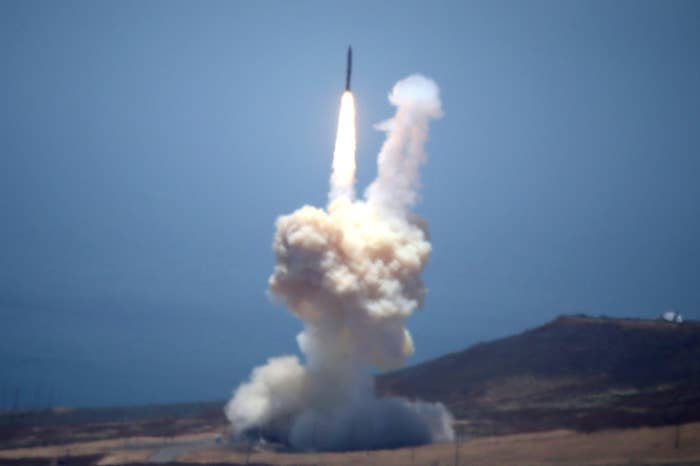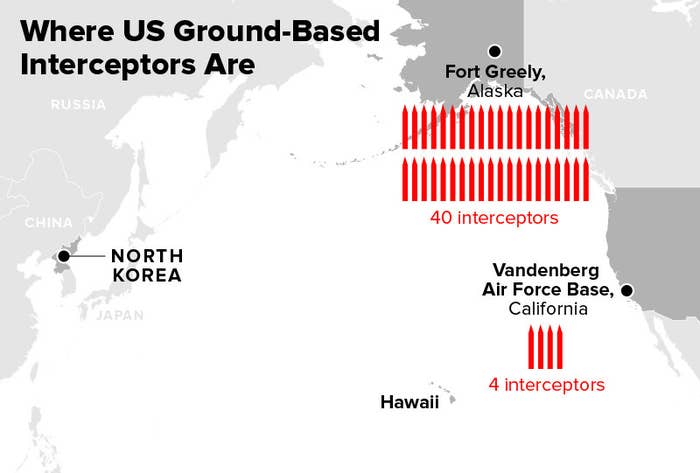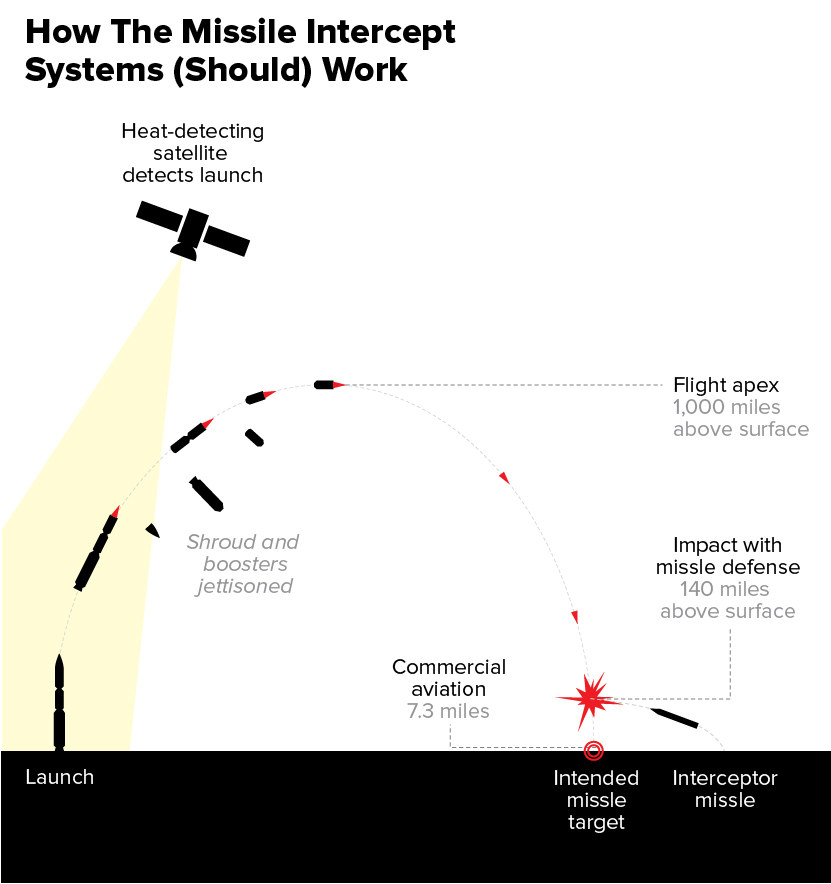
Talks between President Donald Trump and North Korean leader Kim Jong Un could have a benefit no one in the Trump administration really wants to acknowledge — taking some of the pressure off a missile defense system whose effectiveness few are certain of.
The Trump administration has been walking a fine line for the past year between expressing public confidence in US defenses and urgently pressing for billions in new spending to upgrade a missile defense system that officials admit is racing to keep up with North Korea’s rapidly evolving missile threat.
Trump famously vowed last year that any North Korean aggression will be “met with fire and fury like the world has never seen.” The US has weapons “that can knock out a missile in the air 97% of the time,” he promised.
The US military knows that’s not true.
The US can’t easily shoot down the kind of ICBMs that North Korea has been testing, and the military’s complex missile defense system is lagging years behind where its leaders would like it to be.

There's still no agenda for the proposed meeting between Trump and Kim, no date for when it might happen, and no location has been selected. It would be Kim's first meeting with any world leader since he assumed power in 2011, and the first ever between a US president and a North Korean leader — reasons enough to be skeptical about its prospects.
And no one thinks the talks, if they do take place, will lead to a reduction in the US push to modernize its missile defense. “The US should seize the moment, and be very aggressive about making progress,” retired Air Force Lt. Gen. Dan Leaf, who served as deputy commander of US Pacific Command and vice commander of the Air Force’s Space Command, told BuzzFeed News. “This is a very good thing, but we’re not done, we ought not to declare victory. There will always be another North Korea.”
Still, the prospect of talks and North Korea's apparent willingness to temporarily suspend nuclear and missile tests is welcome news after a year in which its successful launch of an intercontinental ballistic missile that can reach anywhere in the United States has led to renewed questions about the effectiveness of US defenses.
The current military approach to defending the mainland US from North Korea relies on ground-based interceptors, or anti-missile missiles, launched from underground silos in Alaska or California. They would destroy incoming enemy missiles through the force of direct impact — defense officials often describe it as attempting to “hit a bullet with another bullet.”
After spending more than $40 billion on ground-based missile interceptors, the Missile Defense Agency has successfully intercepted ballistic targets in just 10 out of 18 attempts since 1999. Now the US is racing to beef up its missile defense systems, with Trump’s budgets including hefty requests for more weapons intended to shoot down North Korean missiles. But former Pentagon leaders, nuclear experts, and military planners are strongly divided on whether that makes sense — and whether the current ones even work.
With the military’s ability to defend the US under greater scrutiny, the White House last month requested $9.9 billion for the MDA in the 2019 fiscal year, a $2 billion increase. This is to go largely into building up what's known as the Ground-based Midcourse Defense system, or GMD, which is designed to protect the US mainland from North Korea or possibly Iran. It is not designed for the advanced capabilities of Russia or China.
The US currently has 40 ground-based interceptors deployed in silos at Fort Greely, Alaska, and four at Vandenberg Air Force Base in California. The plan is to deploy 20 additional so-called GBIs to Alaska by 2023, bringing the total from 44 to 64, MDA officials told reporters at the Pentagon last month.
“This is really just throwing good money after bad because we already know that they are not effective,” Philip Coyle, a former assistant secretary of defense who headed the Pentagon’s test and evaluation office from 1994 to 2001, and a senior fellow at the Center for Arms Control and Non-Proliferation, told BuzzFeed News.
He said the Trump administration faces a dilemma in both assuring the nation North Korean missiles can be blocked and asking for more funds to improve missile defense. “Both of those things can’t be true. It can’t be ‘Don’t worry, we got North Korea’ and at the same saying we’re in trouble if we don’t build this up.”
Adding to the pressure is the realization that the US underestimated by five years or more the speed with which North Korea would develop its missile systems. That means the upgrades, including two new radars to scan the Pacific Ocean for threats, won’t arrive for years, even though CIA Director Mike Pompeo warned in January that North Korea was "a handful of months" away from being able to pose a serious risk to Americans.
“None of these systems … are projected to be fielded before the mid- to late 2020s,” Gen. Robin Rand, who leads Air Force Global Strike Command, told a military conference in December. “Some people say, ‘Just in time.’ I say, ‘Late to need.’”

“They thought they’d have time to contain that threat until the new systems kicked in around 2023, so there’s absolutely a gap there now,” Riki Ellison, the founder of the Missile Defense Advocacy Alliance, told BuzzFeed News. “Everybody thought that 44 (GBIs) would be enough for the initial North Korea threat. Nobody foresaw the possibility that they would be overmatched. … 44 was the number that they thought could securely handle the expected amount of missiles.”
But that was an underestimate of what North Korea’s missile-building capabilities now appear to be. North Korea has fired 23 missiles in 16 tests since last February, accelerating its push for a nuclear-armed missile capable of reaching the mainland US, a goal it seems to have achieved in November with the firing of a missile that experts determined could fly over 8,080 miles — placing the entire US within its range.
Experts say that North Korea still hasn’t proven that it has mastered all of the necessary missile technology, such as reentry, terminal stage guidance, and warhead activation, to actually hit the US with a missile. But that's not reassuring, even to those who express confidence in US defense capabilities.
“Given where we think the North Korean capability might be in terms of their missiles in three or four years or in the early 2020s, I think we must continue to improve our missile defenses,” Adm. Harry Harris, the commander of US Pacific Command, told Congress in February.
Adding to anxiety over the rapid North Korean progress, the Defense Department is confronting the reality that its missile defense systems are aging, plagued by delays, and untested in realistic conditions of a possible attack.
Since the 44 “kill vehicles” in the existing silos in Alaska and California were put together through piecemeal additions, many are outdated and difficult to fix because they use different parts. The next iteration — called RKV, or Redesigned Kill Vehicle — is meant to be an upgrade that is cheaper, more reliable, and easier to maintain. The MDA is designing it by cobbling together the best concepts submitted by Boeing, Lockheed Martin, and Raytheon.
Even so, the new technology is at least two years away from its first planned test flight, which has already been delayed. None of the experts consulted by BuzzFeed News thought that the 2023 deployment date was realistic.
At the time that the first anti-missile missile was placed at Fort Greely in 2004, two years after President George W. Bush signed a secret directive calling for the deployment of a missile defense system, a North Korean missile capable of reaching the West Coast seemed a remote possibility.
Thirteen years later, it’s not just the West Coast, but the whole continental US in need of protection. Critics say the missile defense system’s track record — which one MDA director described as “Test, fix. Test, fix. Test, fix” — has not kept up with the threat.
After the most recent test in May, the Pentagon’s testing office upgraded its assessment of the US ability to defend itself from “limited capability to defend the US” to “demonstrated ability.”
However, these tests were conducted in daylight, and only intercepted a single incoming missile – ideal conditions that would be unlikely if North Korea were to launch a nuclear attack, experts say, and without realistic decoys or other countermeasures that could foil US defenses.
“These tests are scripted for success,” said Coyle, who served from 1994 to 2001 as an assistant secretary of defense and the head of Pentagon arms testing. “In the few instances where they’ve tried a counter-measure, they picked an object that didn’t look anything like an enemy target. It’s like going going duck hunting and the camouflage to fool the ducks is bright red Christmas wrapping paper.”
So, how worried should Americans be?
Ultimately, for the military, its confidence in missile defense is more complicated than the success rate of shooting down a weapon. It comes down to a series of probabilities, and using the system for deterrence while hoping diplomacy will do its work.
“Many of the same people who cite a single (US) test failure and say this isn’t working are impressed with North Korea’s relentless pursuit of capability,” Leaf told BuzzFeed News.
Long-term development programs are not going to deter Kim Jong Un, and the perfect testing record sought by what he calls the “fly before you buy lobby” is unrealistic, he said.
“It guarantees that whatever we develop lags behind emerging capabilities,” he said. “We’re not going to achieve perfection, but these threats aren’t going away. You can’t bet everything on missile defense.”
The military considers all the factors — the probability that North Korea would launch such an attack before the US hits its launch site, that their weapons would work, and that it wouldn’t be intercepted by the US missile defense system.
“Combine all those probabilities and you’ve got a pretty good bet on countering such an attack,” Leaf said. “Is it 100? No, but it’s a probability that I’m pretty comfortable with.”
The Pentagon’s missile defense program has been intensely scrutinized in recent years, with test failures and long delays calling into question the program’s credibility. Many nuclear experts have long alleged that it’s not that the US lacks the necessary technical expertise, but that an incompetent bureaucracy at the Missile Defense Agency results in billions of taxpayer dollars being pumped into slow moving, poorly designed programs.
The MDA, which has operated outside the Pentagon’s usual oversight process since 2002, ends up with “gross incompetence” that is compounded by senior military officials who try to rush these systems into deployment before they are properly tested, critics say.
Or, in the words of a retired president for missile systems for Lockheed Corp., “this whole subject is fraught with bullshit from both sides.”
David Montague, who in 2012 chaired a National Academy of Sciences panel that assessed US missile defense systems at the request of Congress, says lawmakers and military officials have asked for input from experts like himself for decades without acting on the results.
“You’ve got at least three decades of waste, fraud, and abuse,” he told BuzzFeed News, pointing out that missile defense spending by now has a higher price tag than the entire Apollo moon program, with many systems never even being deployed. “It’s a feeding trough for industry and laboratories.”
The Pentagon is getting ready to release a missile defense review ordered by Trump, the first one since 2010. It is expected to call for a major ramp-up in its defense systems against threats from Iran and China in addition to North Korea. It has also dropped the term “ballistic” from its title, which many experts say is significant and shows that the focus will extend to a wider range of threats.
“What this means is that the Trump administration is now doubling down on the idea, the faint hope, that there is a technological solution to missiles, but not only ballistic missiles,” said Coyle. “These are all really tough if not impossible technological problems.”
The Pentagon will have to walk the line between rating how effective the current defense systems are while also making the case for ramping them up, he said.
The last time this review was released, in 2010, Coyle said he was “very surprised to see that the review very much claimed that we were just fine.”
“I knew that Obama didn’t believe that, but it was what the report said,” he said. “If everything is hunky-dory, why do we need all these new systems? So one thing to look for is the degree to which it will hype the threat, since the Pentagon needs a good threat in order to justify this.”

